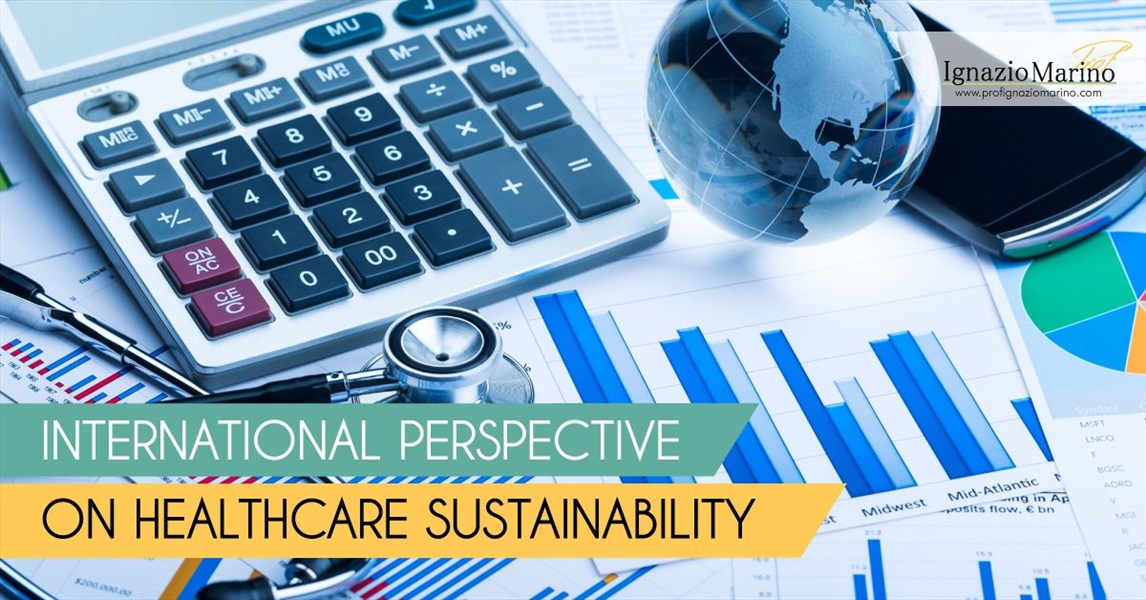International Perspective on Healthcare Sustainability
by Ignazio R. Marino, MD, ScD
Population Health News (April 2018, Volume 5, Issue 4)
Healthcare systems vary consistently between countries but most are facing similar challenges. The changing medical, demographic, technological conditions and the impact of financial and economic austerity create new demands at a time when the public are seeking improvements in access, quality and scope of the services available.
Healthcare systems can be judged by a number of criteria: quality, efficiency and equity, that are seldom evenly balanced. The US system scores very highly on quality, less on equity. In comparison, the British and the Italian systems appear to do better on equity and accessibility.
One common trait, however, is that all existing systems are unlikely to remain sustainable in the longer term, unless additional or new forms of funding are provided and innovative approaches are adopted. Also, differences between systems that were born as opposite in principle, become thinner and decision makers are now facing challenges that are literally global.
Progress in this area is particularly hard to achieve, no matter where we look, partly because of lack of dedicated resources, for political resistance to touch such a sensitive issue running the risk of losing public consensus, and partly because of the difficulty to affect lifestyles and invest in prevention. Nonetheless, general principle sand new guidelines can possibly be derived from international comparisons of different health systems.
When I was a young resident, in the late ‘70s, we used to open a patient’s abdomen to understand what the problem was. CT-scan technology literally revolutionized the way my generation practiced medicine, affecting timing,goals and outcomes. But it was not just about diagnostics. It is hard to believe that my biochemistry book in medical school dedicated only 4 pages to the DNA.
Medicine has changed more in the past few decades than in the entire 19thcentury, and this has affected the way we live, get sick, get treated, and die. If you were born in 1900, you had a pretty good chance of dying by your 50thbirthday. Nowadays, thanks to improved health and safety measures around the world, children, especially girls, have extremely good chances to live as long as 100 years. The National Institute of Aging Report puts this in stark terms: "The 85-and-overpopulation is projected to increase 351% between 2010 and 2050, compared to a 188% increase for the population aged 65 or older and a 22% increase for the population under age 65."1 This explains why most people are in panic mode about health coverage and Social Security.
However, although life expectancy has improved everywhere over the past decades, there are still stark differences among most European states that occupy top positions on the list of countries with the longest life spans, and,say, the United States. Infant and maternal mortality rates are another commonly cited international comparison of health status. Despite spending about 17% of their GDP on healthcare – more than any other industrialized nation – the USA has the worst rate of maternal mortality in the developed world.
Their low ranking is often used to question the direct relation between wealth and health quality. Spain and Italy, countries that certainly can boast the recognized benefits of the Mediterranean diet and reduced risk of several chronic conditions, do indeed have better ranking for life expectancy and death rates. Lifestyle does count when it comes to health and longevity. An incredible impact on health outcomes and on a country’s health conditions could be achieved investing more in prevention and in the promotion of healthy lifestyles. But then again, it is not only about lifestyles.
There are conditions that cannot be affected by prevention or lifestyles, but that can be tackled only through expensive treatments, which introduces another issue for debate: drug price. According to industry executives, high prices cover the expense of developing new medications. One popular study estimates the industry’s cost of creating a single drug at $ 2.6billion. One pill of Sovaldi, for instance, an antiviral medication used to treat chronic hepatitis C costs 1,000 dollars in the United States, and 11 dollars in Egypt. Drug prices in our country are particularly high because, unlike elsewhere, the government does not use its purchasing power to contain them. There is nothing like the UK’s National Institute for Healthand Care Excellence (NICE), or the Italian Agenzia Italiana del Farmaco (AIFA), acting as a gatekeeper for new medicines.US healthcare costs are the highest in the developed world and pharmaceuticals account for only 1 in every $10 spent on health.
Still, they are among the most visible to patients because of the steep co-payments demanded by insurers. In 2015, for the first time in history, the US Senate Committee on Finance wrote to a big pharma CEO expressing concerns about the extent to which the market is operating, probably thinking of pricing strategies for treatments that in non-US markets contemplate significant lower prices than what is set for US patients.2 Despite several Congressional inquiries since the 1980s,the inquiry on the new drug for hepatitis C treatment has become a case study and possibly the basis for a timid attempt at changing the traditional rhetoric between the government and private pay ors – a type of action that is more standard practice in countries with different health care systems.
A possible form of positive monitoring, mutated from the pharma world, could be the introduction of regulatory requirements for clinicians to prove that a new procedure is necessary and not harmful, just like drug companies must do before selling anew pharmaceutical. Howard Brody of the University of Texas Medical Branch maintains that waste, defined as spending on interventions that do not benefit patients, amounts to at least 30% of the US healthcare budget and is a major driver of cost increases.3 A list of 135 procedures, often used for decades, was made by medical specialty groups for medical tests and treatments considered as almost always unnecessary and often harmful.
The list was released in 2013 by the professional societies of 17 medical specialties ranging from neurology and ophthalmology to thoracic surgery and was made without considering costs. It was part of a campaign called Choosing Wisely, organized by the American Board of Internal Medicine’s foundation. Some believe that avoiding waste could allow universal coverage in the United States, but even a more modest goal - saving billions of dollars in wasteful spending –would be a much needed intervention.
If it is not only about lifestyles, as I mentioned before, it must have something to do with the kind of health coverage that people have. Universal health coverage does seem to improve health outcomes and protect people from the risk of impoverishment.And yet the endless debate over the advantages and disadvantages of such a system is getting complicated now that challenges typical of a system mainly based on private insurances start affecting also socialized medicine.
Looking at the Italian National Health Service (Servizio Sanitario Nazionale – SSN), a system ranked second best in the world by the World Health Organization, can provide interesting insight. Created in 1978 and inspired by the British National Health Service, SSN has two underlying principles: every citizen and every foreign resident has the right to healthcare, and all necessary treatments are covered. Over the last thirty years, SSN has assured a good standard of universally accessible services. Today, however, the system finds itself operating in very different circumstances to the past, due to technical advances, demographic trends, increasing demands, economic constraints and ethical considerations. In order to address these challenges, the Italian healths ystem will need to make progress in several key directions: prevention of disease and efficiency of facilities; reduction of regional disparities in performance;formulation of a national health policy integrated with the country’s industrial priorities; simplification of bureaucracy.
Among the measures that seem more urgent, Italy should promote increased accountability and autonomy of medical staff; the creation of new professional roles; the strengthening of IT and digital support tools; and the systematic introduction of monitoring, evaluation, and merit-rewarding mechanisms. In general, the sustainability of Italy’s healths ystem will depend on its ability to embrace change while resolving short-term problems and planning long-term development and innovation. A radical transformation should entail that the healthcare system must change from being a simple cost center to become a center of investment and promotion of excellence, with the introduction of controlled competitive elements, including forms of public-private collaboration.4 Interestingly enough, this seems to be a recipe that is directly inspired by radically different health care systems.
On the other hand, according to many, the fundamental problem in the US health care system is that the structure of healthcare delivery is broken because a dysfunctional kind of competition, not based on value and results, has taken over.5 In other words, the healthcare transformation that is so needed has more chances to happen if the system joins the consumer revolution than through measures imposed by the federal government.6 Millions of vulnerable Americans are better protected after the introduction of the Affordable Care Act, but the expected breakthrough change has only partially occurred, mainly because it is not only through complicated legislation that disparities can be mended.
The goals of medicine (relief of suffering, prevention and cure of disease, promoting of a peaceful death) seem incompatible with managed care, if this is intended as a system of integrated healthcare delivery designed to control costs.This depends on how legitimate profit is sought, whether the integrity of physicians' medical judgment is protected, and whether government regulations effectively prevent abuse and enhance the quality of care.
The principle of value-based competition applies to any health care system. There is a growing recognition of the need to focus on value, to introduce competition into state-dominated systems, and – conversely – to rethink how providers are organized in private systems.
Talking about sustainable development of global health, Richard Horton, Editor-in-Chief of The Lancet, has advocated for a shift from a public health model to a planetary health model, defining planetary health as “the health of human civilization and the state of the natural systems on which it depends—the way we organize our political, economic, social,environmental and technological systems to address the predicaments we face.”7 According to Horton, considering how codependent on a healthy population economic growth and development are, but also how limited our resources are, we really should start looking beyond the health system, work at the interface between all sectors for sustainable development,engage with industry to address conflicts of interest, and communicate better to improve solidarity and achieve goals together for ourselves and future generations. Not an easy task, but certainly one that international dialogue andi nterdisciplinary collaboration must undertake.
1. Mahishale V. Ageing World: Health Care Challenges. J Sci Soc 2015;42:138-43.
2. Senators Ron Wyden and Charles E. Grassley (2015), “The Price of Sovaldi and Its Impact in the U.S. Health Care System” Committee on Finance, United States Senate
3. Brody H. From an Ethics of Rationing to an Ethics of Waste Avoidance. N Engl J Med 2012; 366:1949-1951.
4. Aspen Institute Italia, Rome, 21/09/2016, National Roundtable
5. Porter, Michael E., and Elizabeth O. Teisberg. Redefining Health Care: Creating Value-Based Competition on Results. Boston:Harvard Business School Press, 2006.
6. Stephen K. Klasko, Gregory P. Shea, Michael Hoad We Can Fix Healthcare: The Future is Now . Mary Ann Liebert, Incorporated,Publishers, 2016.
7. Richard Horton. “Sustainable Development Is about More than Global Health”. Keynote speech at the Duke Global HealthInstitute’s 10th anniversary symposium, October 11, 2016.
Acknowledgement
I am thankful to Claudia Cirillo who assisted with background research and preparation of the paper.
Ignazio R. Marino is Professor of Surgery, Sidney Kimmel Medical College at Thomas Jefferson University, Senior Vice President for Strategic Affairs and Director of the Italy Center, Global Jefferson.
 06.60301809
06.60301809






